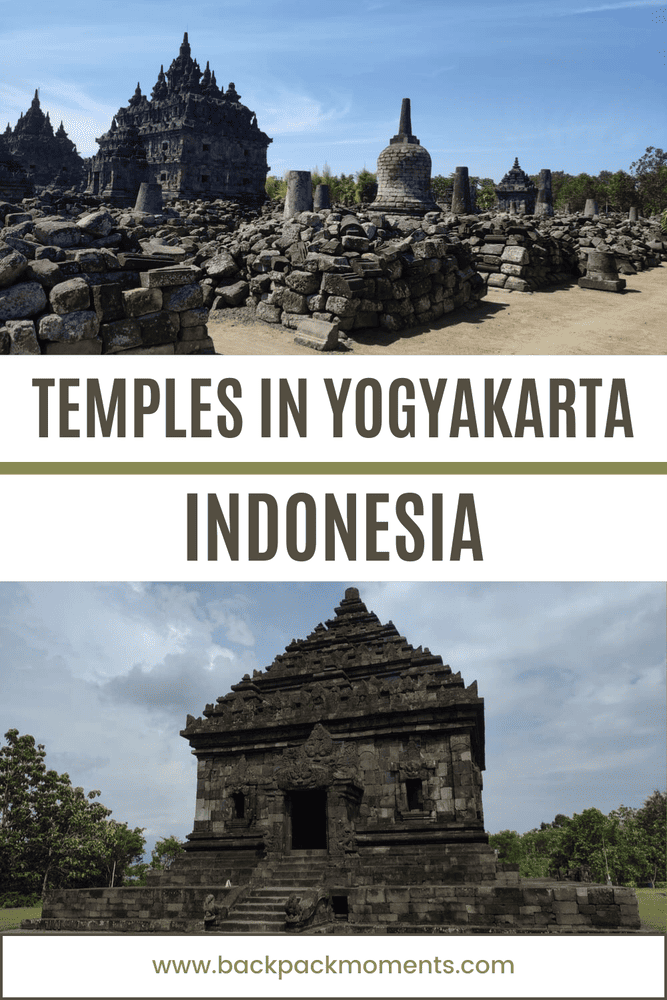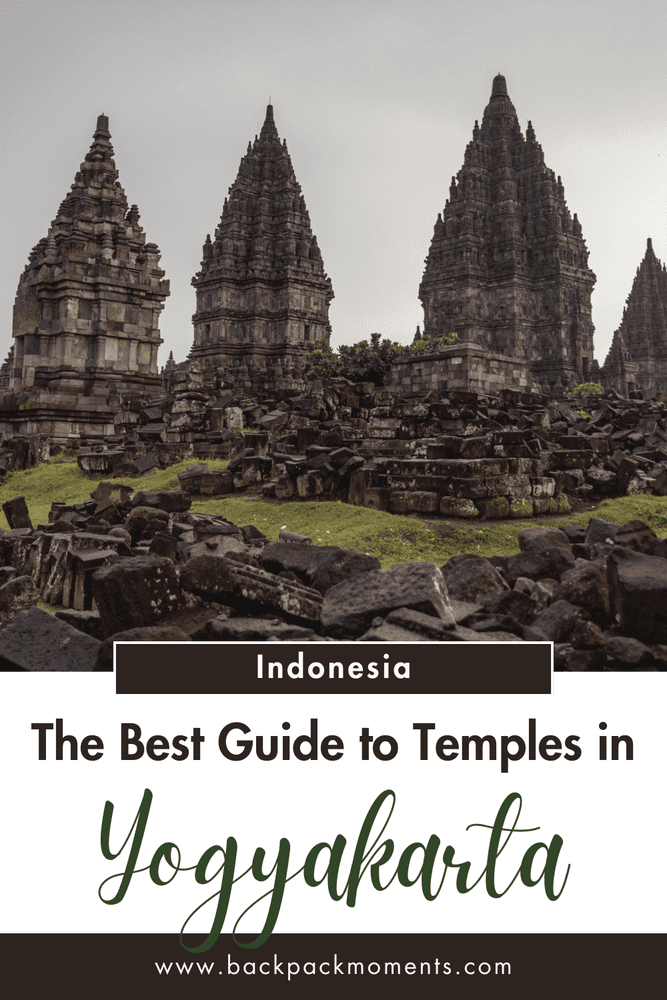20 Mystical Temples In Yogyakarta (+fun facts)
This post may contain affiliate links. If you make a purchase using one of these links, I may receive a small reward at no extra cost to you. See my Disclosure Policy for more information.
Although the Indonesian island of Java today is mostly Muslim, it wasn’t always like that. Hundreds of Buddhist and Hindu temples are scattered all around the island.
One place that stands out with a very high concentration of ancient temples is the region of Yogyakarta.
Most travelers come to Yogyakarta for a day or two and rush to visit the magnificent Borobudur and Prambanan in 1 day. But if you stay a few more days, you can visit more than 20 temples!
From those just behind Prambanan and those that line up perfectly with Borobudur to those hidden in the jungle as if frozen in time – I will tell you why you should visit them and how to get there!
Yogyakarta is a 3-day stop on my 14-day Java Backpacking Itinerary. Visiting more temples is an optional activity for those in love with Java’s ancient history.
Candi is the Indonesian word for temple. I use them interchangeably in this article.
Map of Temples around Yogyakarta
- Red = Hindu Temples
- Purple = Buddhist Temples
- Yellow = Ratu Boko
Hindu Temples in Yogyakarta
Hinduism was one of the first religions in Java and has a profound and visible influence on the Javanese people to this day.
Many folk beliefs, spiritual practices, and Hindu customs persist in the lives of people in East and Central Java, including Yogyakarta.
Hindu Temples are a great cultural and architectural heritage of Yogyakarta and it’s truly marvelous that some of them are still standing strong and so close to the city too!
1. Prambanan
- Location: MAP
- Open: 7:00 AM – 5 PM, Closed on Mondays.
- Ticket price (foreigners): 375.000 IDR (25$).
- Combo ticket price with Borobudur OR Ratu Boko: 675.000 (45$)
Candi Prambanan is spectacular!
It is the largest Hindu temple in Indonesia and is dedicated to the triad of gods Brahma, Vishnu, and Shiva, also called the Trimurti. It was built sometime during the 9th century.
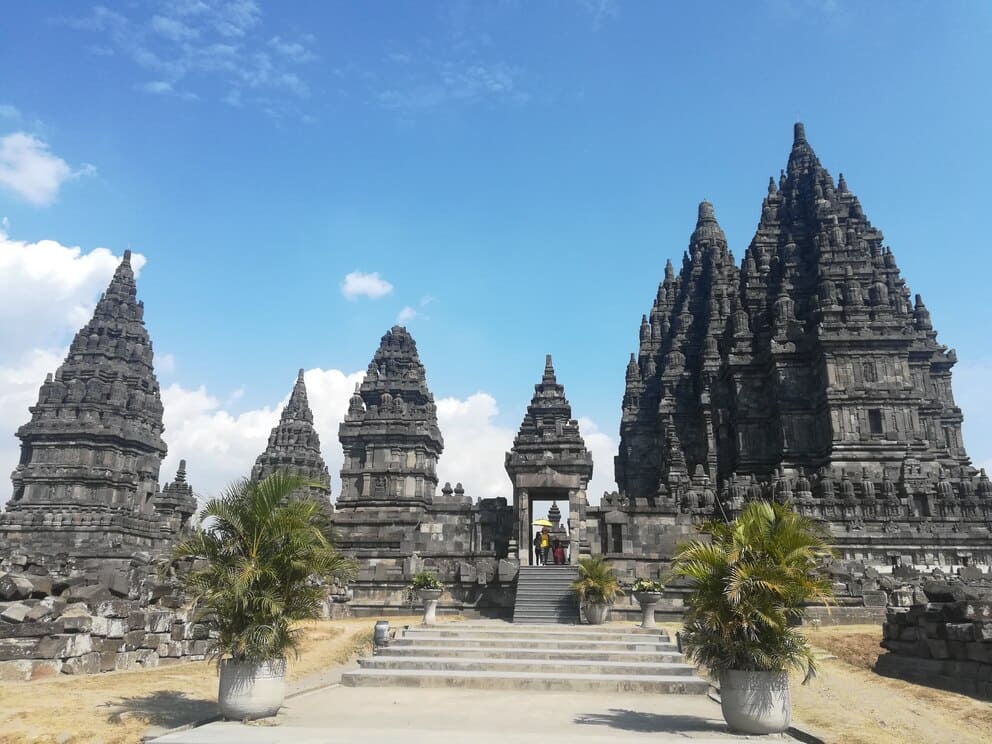
What you may not know is that Prambanan is a complex of a whopping 240 temples! In the middle is the grand temple dedicated to Lord Shiva, 47 meters high! The temple is intricately decorated with reliefs from the Epic of Ramayana.
North of it is the Vishnu Temple and south of it is the Brahma Temple. Together they create a stunning view very conducive to picture taking and Instagram bragging (especially during sunset).
All around them smaller temples and shrines are scattered – some intact, some damaged, some only a pile of stones.
On the grounds of the Prambanan temple, you can also find Lumbung, Bubrah, and Sewu Temples (see more about them in the Buddhist section).
You can reach Prambanan by public transport from Yogyakarta, namely the 1A/K3J bus from Malioboro.
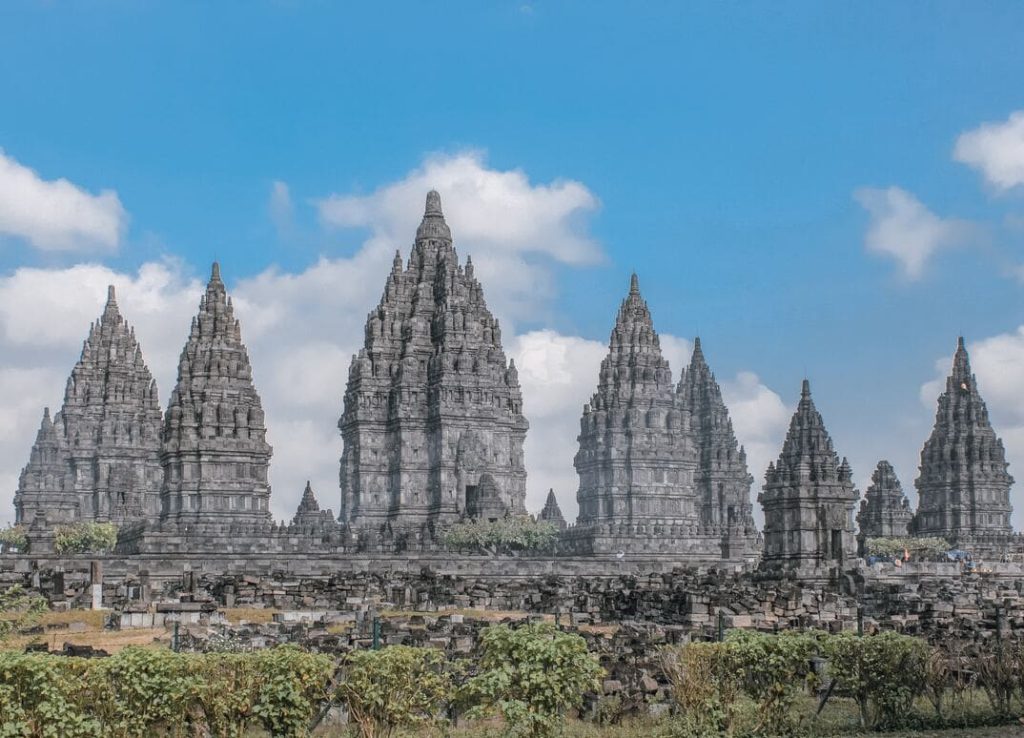
If you can only visit one temple in Yogyakarta, let it be Prambanan! You should also watch the Ramayana Theater which takes place every Tuesday, Thursday, and Saturday.
Reason to visit: A UNESCO site, the biggest Hindu temple in Indonesia, and the second-biggest in all of Southeast Asia.
2. Sambisari
- Location: MAP
- Open: 9 AM – 5 PM (4 PM between Tuesday and Friday), Closed on Mondays
- Ticket price (foreigners): 15.000 IDR (1$).
Sambisari was discovered by accident when in 1966 a local farmer hit the top of the temple with his hoe while plowing the land.
Candi Sambisari is dated to the beginning of the 9th century and bears a resemblance to Prambanan, albeit on a much smaller scale. Bear in mind that the temple is only partly excavated.
Sambisari temple is an exact copy of the Kedulan temple.

Reason to visit: It is way less crowded than more popular temples, an opportunity for good pictures or quiet admiration.
3. Barong
- Location: MAP
- Open: 8 AM – 6 PM
- Ticket price (foreigners): 10.000 IDR (0.7$).
Candi Barong is a three-level terraced temple, which is unique among the temples in Yogyakarta.
These layered terraces are also known as punden berundak and are a testament to the ancient building techniques of pre-Hindu societies on Java.
The kala’s head on top of the temple resembles the Hindu creature Barong, hence the name of the temple.
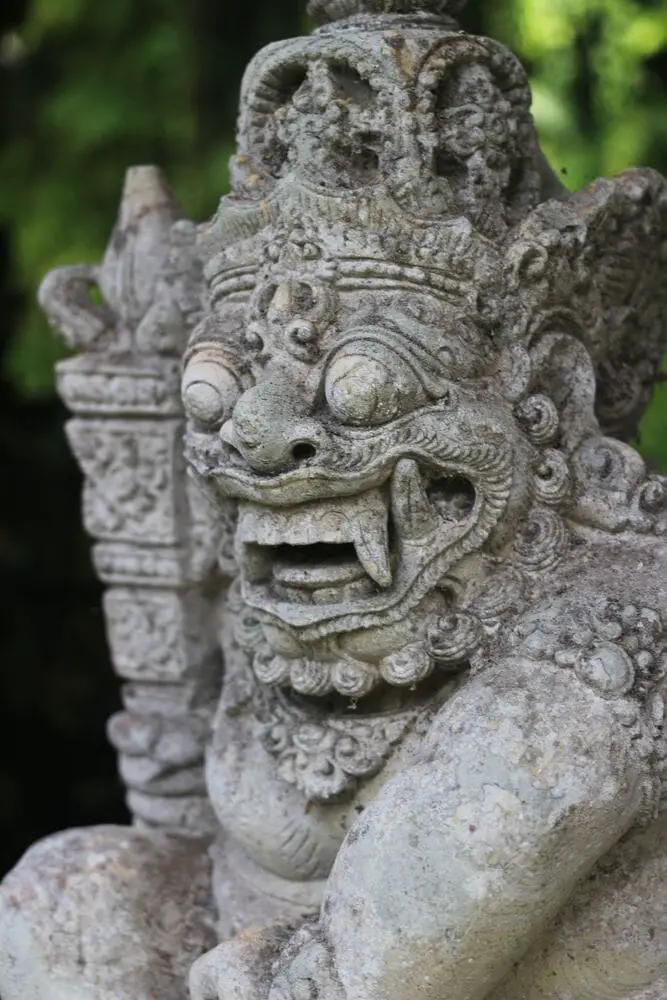
Candi Barong is located within walking distance of Ratu Boko, and Candi Banyunibo so you can combine them.
Reason to visit: It’s unique for being shaped like a stepped terrace.
4. Ijo
- Location: MAP
- Open: 9 AM – 6 PM (Sat & Sun 7 AM – 6 PM)
- Ticket price (foreigners): 15.000 IDR (1$).
Candi Ijo takes its name from the Gumuk Ijo hill on which it is located. The high altitude compared to its surroundings allows you to see a lot of the area around the temple.
There are three Perwara temples (guardians) in honor of the Trimurti (like in Prambanan) and a bigger main temple with carvings and niches all around.
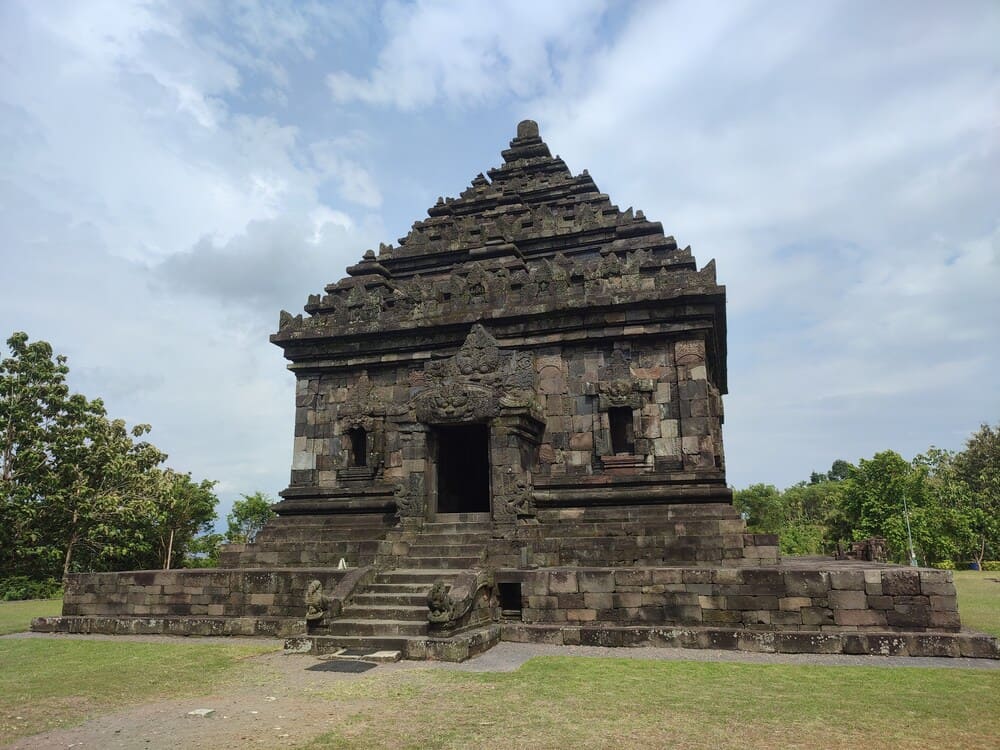
Climbing on the main temple is not allowed, but the grassy lawns are perfect for a picnic lunch, something rare for other temples in Yogyakarta.
Reason to visit: Good views and a lovely grassy lawn.
5. Kedulan
- Location: MAP
- Open: 9 AM – 5 PM
- Ticket price (foreigners): FREE
Candi Kedulan is a small complex of 1 main temple and 3 smaller ones. It was recently discovered buried under centuries of volcanic ash similar to the Sambisari Temple.
Both temples have the same layout – one bigger temple with 3 smaller ones in front.
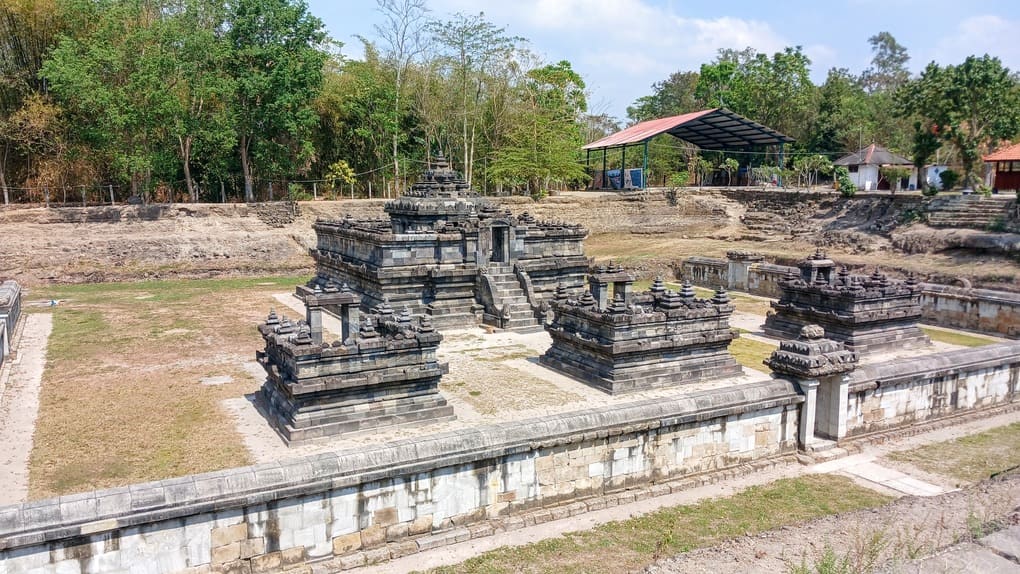
The smaller temple on the left symbolizes female fertility, the one on the right symbolizes the male ‘appendage’ and the middle one has a statue of a cow inside symbolizing Krishna. Remember that cows are sacred in Hinduism!
Go to the security guard shack on the north side before you enter.
All you have to do is enter your name and sign. It’s officially opened and free to enter, although soon it might have an entrance fee similar to nearby Sari and Kalasan temples.
If there’s nobody, you can still walk around the temple as the temple is visible from the outside.
Kedulan temple was only recently (almost completely) dug out and restored so it looks clean and tidy today.
Reason to visit: Off-the-beaten track, no crowds, and free.
6. Gunung Wukir
- Location: MAP
- Open: 8 AM – 5 PM
- Ticket price (foreigners): FREE
Do you want to feel like Tomb Raider by visiting a temple that almost nobody else ever goes to? Then climb up to Gunung Wukir and check out what remains of the Candi on top. Not much, actually. Only worth it if you have your own transport.
If you have just visited Borobudur with a motorcycle, then Gunung Wukir is a good stop on your way back to Yogyakarta.
Reason to visit: Gunung Wukir is the oldest surviving temple in Java dating to 732.
7. Gebang
- Location: MAP
- Open: 8 AM – 5 PM
- Ticket price (foreigners): 15.000 IDR (1$)
This is the closest temple to the Yogyakarta city center.
Gebang Temple was discovered in 1936 when a local stumbled upon a Ganesha statue (the Elephant-headed Hindu god). Like similar temples in Yogyakarta, it was covered by meters of volcanic ash that came from Merapi.
Gebang is one of the oldest temples in Java, dating to the 8th century.
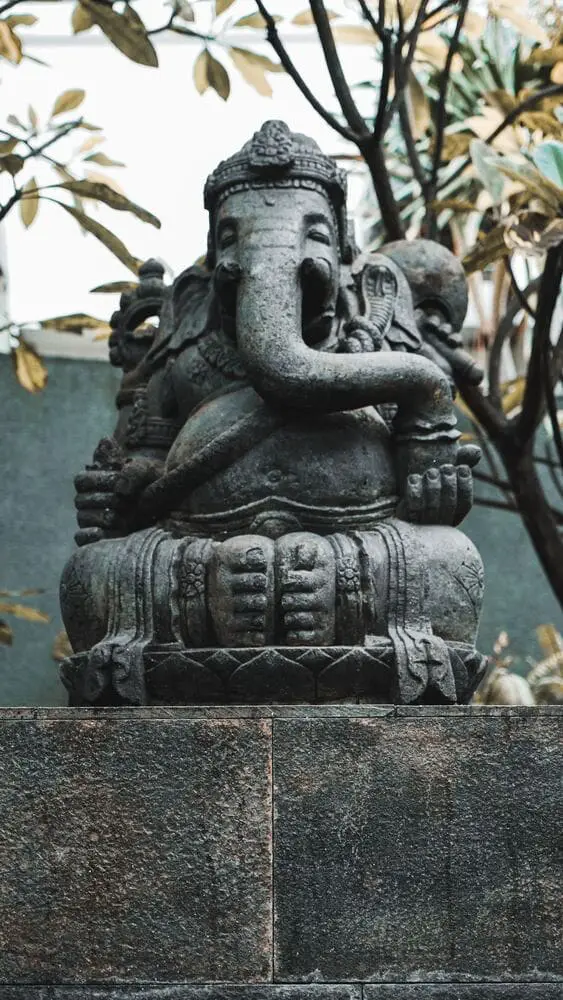
The temple is small but has a pleasant green ambiance. You can reach it from Malioboro taking bus #3B.
Reason to visit: Quiet, peaceful, green, and close to the city.
Buddhist Temples in Yogyakarta
Buddhism is the second oldest religion in Java after Hinduism. The two religions are closely connected. Their spread and development go hand in hand.
Buddhist temples from the 8th to 11th centuries, the time of the Shailendra Dynasty, the Srivijaya Empire, and the Mataram Kingdom can be found all around Yogyakarta.
Let’s take a look at some of the Buddhist temples in Yogyakarta that you can easily visit.
8. Borobudur
- Location: MAP
- Open: 7:00 AM – 5 PM, Closed on Mondays
- Ticket price (foreigners, no climb): 375.000 IDR (25$)
- Ticket price (foreigners, climb): 455.000 IDR (30$)
- Combo ticket price with Prambanan OR Ratu Boko: 675.000 (45$)
Borobudur was discovered during the British occupation of Java in 1814. I bet it was as impressive then, as it is now, although it had been buried in ash and thick vegetation.
It took the men two months of hard work to clean up the jungle and dig out the ash to reveal the temple. It wasn’t until 1835, over 20 years later, that the entirety of the temple was unearthed.
What you see today was the result of anastylosis restoration in 1911, in other words, the same materials that made up Borobudur were reused to restore it to its initial look. Or as close as possible – still some reliefs sit below eye level and aren’t visible.
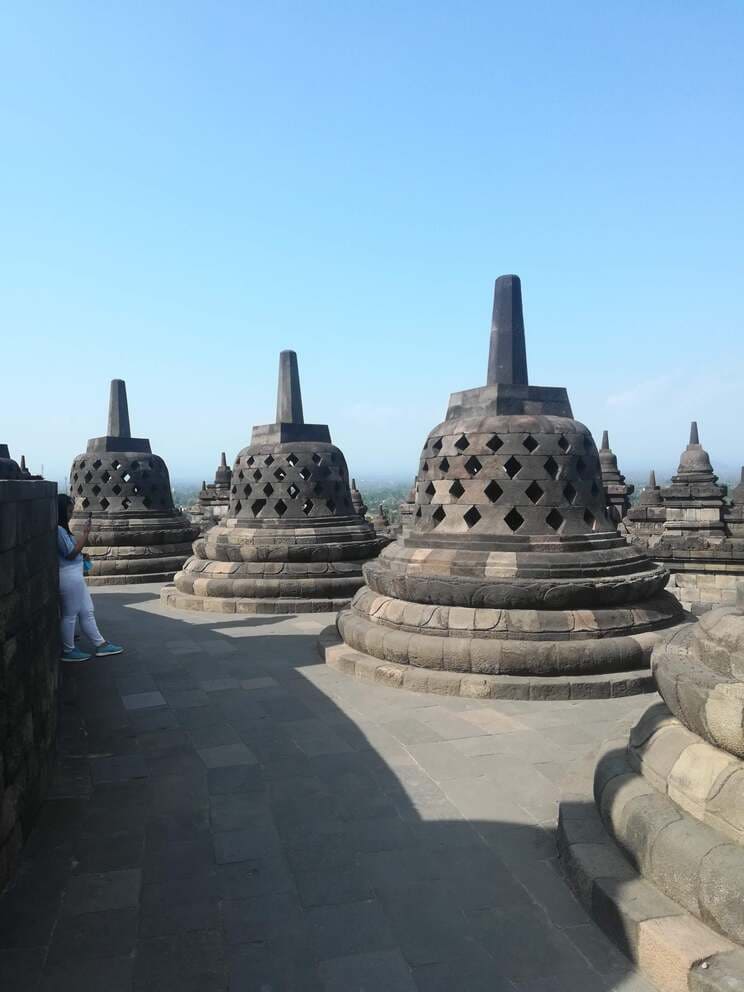
If you want to read more about it, I recommend the book Chandi Borobudur; a Monument of Mankind. Click here, if you want to find out how to climb up Borobudur and watch the sunrise.
Borobudur lies on a straight line together with Candi Mendut, Candi Pawon, and Candi Ngawen. It is believed that the four temples had a ritual relationship, but what exactly is unknown.
Reason to visit: It’s the biggest Buddhist temple in the world, a UNESCO heritage site, and all-in-all an impressive sight to behold.
9. Candi Mendut + Buddhist Monastery
- Location: MAP
- Open: 7:00 AM – 6:00 PM, Closed on Mondays
- Ticket price (foreigners): 20.000 IDR (1.4$), including entry to Candi Pawon.
- Ticket price for the monastery: FREE
Candi Mendut was built in 824 by the first king of the Shailendra Dynasty – King Indrain.
Candi Mendut was discovered in 1836 and restored in 1904 by the Dutch colonial administration.

Vesak Day (the next one is on May 23, 2024) is a special day for Mendut, Pawon, and Borobudur. Buddhists gather to celebrate the holy day of Buddha’s birth. The procession starts from Candi Mendut, goes to Candi Pawon, and ends at Candi Borobudur.
The nearby Mendut Buddhist Monastery is free to enter and is only a minute away from the temple. It’s very peaceful and extremely well-kept. I was quite surprised just how clean and orderly everything was there!
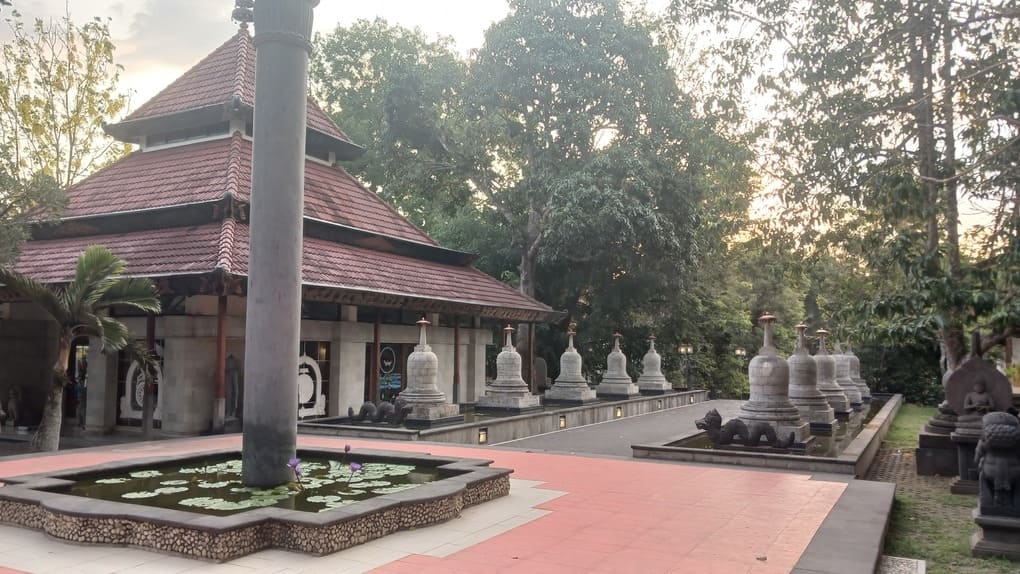
Reason to visit: It’s part of the Borobudur Quartet with a rare Buddhist Monastery from the 9th century near it.
10. Pawon
- Location: MAP
- Open: 7:00 AM – 5:00 PM, Closed on Mondays
- Ticket price (foreigners): 20.000 IDR (1.4$), including entry to Candi Mendut.
Compared to all the other temples I’ve listed here, Pawon is tiny. It gives you a sense of appreciation for just how many smaller shrines and temples are spread around the humongous Borobudur.
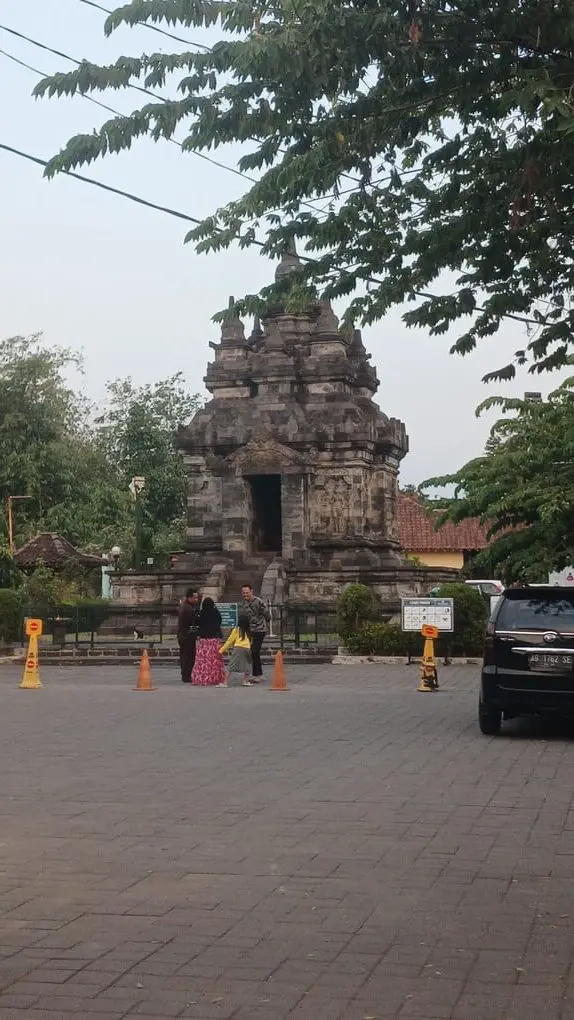
Interestingly, Pawon predates Borobudur by a few years. Yup, Borobudur may be the biggest, but it’s not the oldest!
Reason to visit: It’s part of the Borobudur Quartet. Small, but tidy and pretty.
11. Ngawen
- Location: MAP
- Open: 8:00 AM – 4:00 PM
- Ticket price (foreigners): FREE
Most guides and tourists do not go to this small temple. Ngawen is very similar to Pawon in that it’s small and older than Borobudur. Since you’re reading this, you’re a temple lover, so give Candi Ngawen some love!
Reason to visit: It’s part of the Borobudur Quartet. Free and no tourists.
12. Sewu
- Location: MAP
- Open: 7:00 AM – 5:00 PM, Closed on Mondays
- Ticket price (foreigners): Included in the Prambanan ticket
Sewu temple is the second-largest Buddhist temple in Indonesia (after you know which one). “Sewu” means 1000 in Javanese, although there are a measly 249 temples on the grounds. Very few, I know, right?
The original name of the temple was Manjusri Grha (The House of Manjusri) and was built before both Prambanan and Borobudur!
Just like Borobudur, Sewu is arranged in a mandala, which is visible if looked at from above.

In the past, each of the temples contained a Buddha statue, but these are all gone. Even the biggest temple of the Sewu complex today only contains an empty lotus-carved stone pedestal.
As far as temples in Yogyakarta go, Candi Sewu is one of the most beautiful in my opinion!
Reason to visit: Second biggest Buddhist temple in Indonesia, looks very cool, and is part of the Prambanan ticket.
13. Bubrah
- Location: MAP
- Open: 7:00 AM – 5:00 PM, Closed on Mondays
- Ticket price (foreigners): Included in the Prambanan ticket
Candi Bubrah is located just 300 meters south of Sewu and is considered to have been a guardian temple. It was added later to complete the mandala as the guardian on the south side of the complex.
In Javanese, the name Bubrah means “Ruins” because when it was discovered in the 19th century that is what it was – a pile of rubble. In 2017 the temple’s expensive reconstruction finished and now it’s part of the Prambanan complex.

Reason to visit: Part of the Prambanan Complex, spiritually connected to Sewu Temple.
14. Lumbung
- Location: MAP
- Open: 7:00 AM – 5:00 PM, Closed on Mondays
- Ticket price (foreigners): Included in the Prambanan ticket
Lumbung temple is located just meters away from Bubrah. It’s very similar in appearance to Sewu Temple, albeit much smaller.
Lumbung means “rice barn” in Javanese. It’s inside the Prambanan grounds.
Reason to visit: Part of the Prambanan Complex, spiritually connected to Sewu Temple.
15. Plaosan
- Location: MAP
- Open: 8:00 AM – 4:30 PM
- Ticket price (foreigners): 50.000 IDR (3.4$)
Candi Plaosan is located about half an hour’s walk from the entrance to Prambanan. If you ask one of the becak drivers in front to bring you there, it should cost you around 20.000 IDR (1.4$).
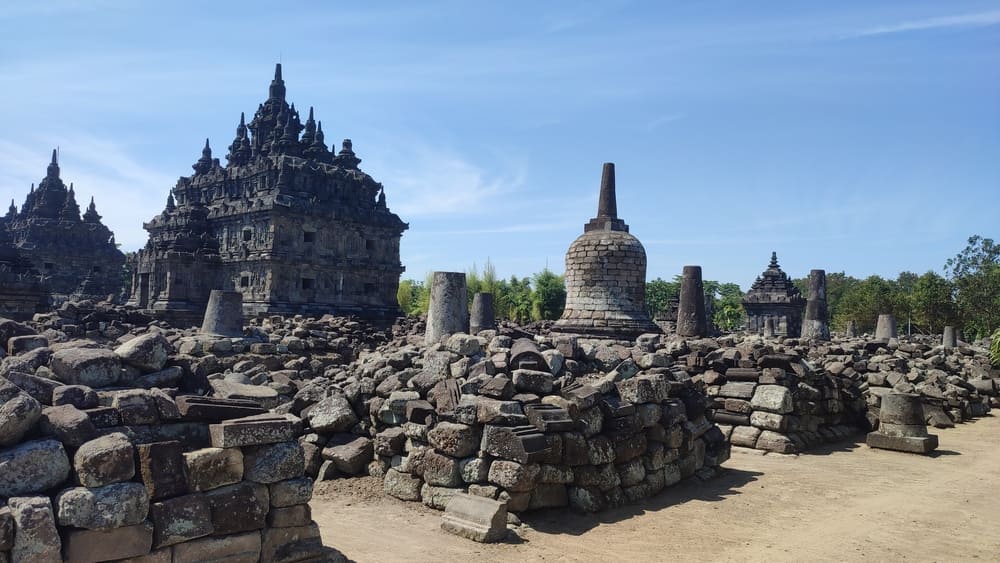
The Plaosan Temple Complex is made up of 174 individual buildings. Most of them are partly ruined, but the stones are piled to create an orderly scene.
Plaosan is not part of the Prambanan Complex, although it’s similar in appearance to Sewu, Bubrah, and Lumbung.
Candi Plaosan is split in two – the north Plaosan Lor is the main part of the temple and the south Plaosan Kidul contains a bunch more buildings. In between is a small market where you can grab lunch, for example, Mie Ayam or some Indonesian snacks.
You can see all the temples from outside the gate and avoid paying the discriminatory high entrance fee (although much smaller than Prambanan’s). The south portion is free to enter.
Reason to visit: A less overrun and less expensive alternative to the Prambanan Complex.
16. Sojiwan
- Location: MAP
- Open: 8:00 AM – 5:00 PM
- Ticket price (foreigners): 50.000 IDR (3.4$)
Candi Sojiwan was one of the temples discovered by the British in the 1810s. After that, it was in disrepair close to Prambanan for decades before it was reconstructed in 2011.
Today it’s a good-looking Buddhist temple, which unfortunately is quite expensive to enter considering its mediocre size. Unless you’re a temple addict, skip this one for cheaper temples in Yogyakarta.
It’s walking distance away (~15 mins) from Prambanan Terminal where the buses to Malioboro stop.
Reason to visit: Another Buddhist candi for temple addicts.
17. Sari
- Location: MAP
- Open: 8:00 AM – 3:00 PM
- Ticket price (foreigners): 10.000 IDR (0.7$)
Candi Sari was probably the monastery for monks who served the nearby Kalasan temple.
It’s in the middle of a residential area and in my humble opinion looks just as fabulous as Sojiwan but for a fifth of the cost.
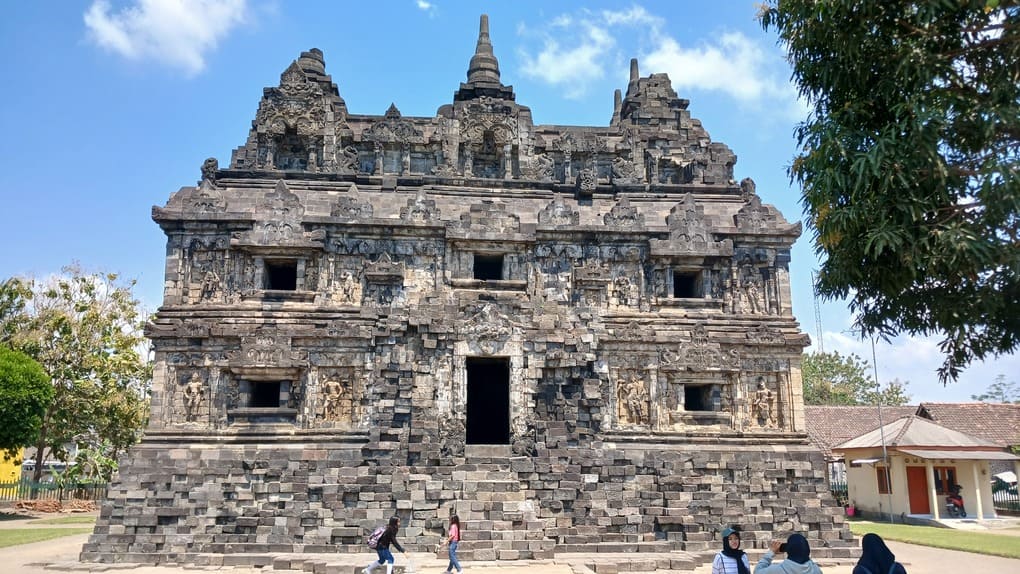
It’s about 25 minutes on foot from Terminal Prambanan.
Reason to visit: Another Buddhist Candi for temple addicts. This one is much cheaper.
18. Kalasan
- Location: MAP
- Open: 9:00 AM – 5:00 PM
- Ticket price (foreigners): 15.000 IDR (1$)
As you’re riding the bus from Yogyakarta to Prambanan, keep your eyes peeled to the right. Approaching Prambanan, around 2.5 km before the Terminal, you’ll see the imposing building that is Kalasan Temple.

On one side it’s a pity that Kalasan is not as well-maintained as Sewu and Prambanan (edit: restoration works have started!), but on the other it allows it to have a more ancient, more mystical look and appeal. And for a fraction of the cost!
Reason to visit: Easy to reach and cheap.
19. Banyunibo
- Location: MAP
- Open: 8:00 AM – 5:00 PM
- Ticket price (foreigners): 10.000 IDR (0.7$)
Banyunibo is a lonely Buddhist temple sitting in the middle of paddy rice fields. The Perwara temples (guardians) of Banyunibo are all in ruinous condition.
Nonetheless, I believe Candi Banyunibo is one of the most underrated temples in the Prambanan Plain and is worth a visit if you’re in the area.
Candi Banyunibo is located within walking distance of Ratu Boko, and Candi Barong so you can combine them.
Reason to visit: A Buddhist temple in a very Zen area and no crowds.
20. Ratu Boko
- Location: MAP
- Open: 7:00 AM – 5 PM, Closed on Mondays.
- Ticket price (foreigners): 375.000 IDR (25$).
- Combo ticket price with Prambanan OR Borobudur: 675.000 (45$)
Ratu Boko is in a category of its own because it is a bizarre mix of Buddhism and Hinduism.
It is one of the main reasons why we know that religious syncretism (i.e. combination of religions and beliefs) was the ideology of Javanese societies between the 8th and 14th centuries.
What is Ratu Boko exactly? We don’t know for sure. Likely, the site wasn’t an actual temple but instead a palace for a king. After all Ratu Boko means ‘Stork King” in Javanese.
Considering the complex has defensive walls, moats, a women’s quarter, meditation caves, and even pools, it most likely was indeed some sort of a palace.

It is indeed an impressive site, but I’m not sure to what extent the price tag on par with Borobudur and Prambanan is worth it.
In my opinion, take the combo ticket for Borobudur and Prambanan and seriously consider if you want to spend 25$ for Ratu Boko.
Ratu Boko is located within walking distance of Candi Banyunibo, and Candi Barong so you can combine them.
Reason to visit: It’s a palace that combines Buddhism and Hinduism – pretty unique.
Even more temples in Java
While Yogyakarta has an extremely high concentration of Hindu and Buddhist temples, you can find more similar temples elsewhere in Java.
I recommend the Hindu temples Sukuh and Cetho which are close to Surakarta. More information about them is in this article about things to do in Surakarta.
Several Hindu temples stand high on the Dieng Plateau which you can get to from Yogyakarta. The biggest is Candi Arjuna.
Several Hindu and Buddhist temples dot the area around Mount Bromo too.
